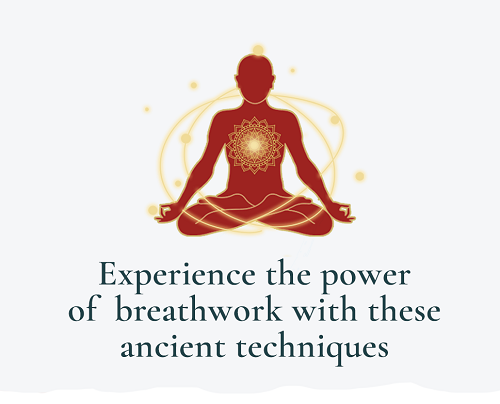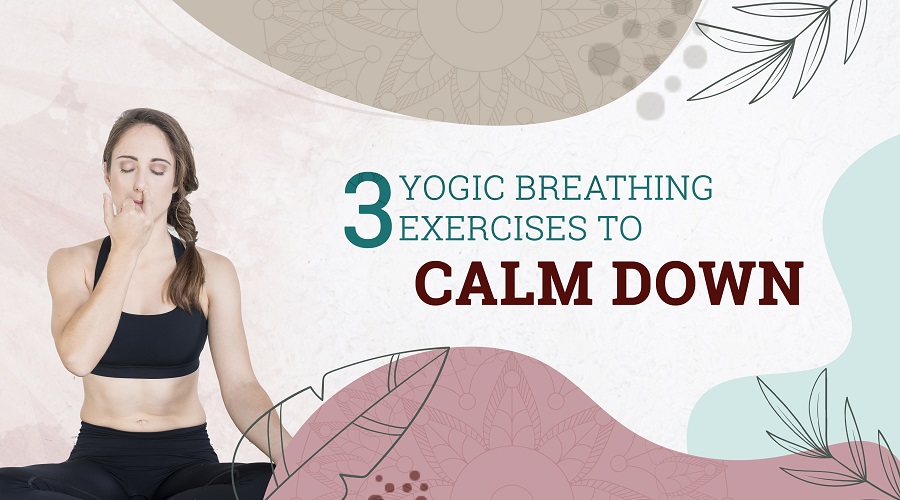3 Yogic Breathing Exercises to Calm Down
Surely you can remember a time when you felt stressed out. Many of us have experienced this during our lives and it is caused by overexerting our bodies and minds. Stress becomes unhealthy when overthinking and excessive worrying are present.
Another cause of stress is the continuous stimulation of our senses. We are often vulnerable to the push and pull of all the arousing sense objects in the world. Our thoughts are unleashed toward the world and we then can feel stressed and off-balance.
The stress we experience can often seem unbearable. It may feel as if our bodies and minds are out of our control, and, to an extent, they are.
It is helpful to understand how stress affects us. A stressor triggers a shift into the fight-or-flight state of our autonomic nervous systems. As a result, this creates physical stress responses that heighten our psychological experiences of that same stressor. As the word 'autonomic' suggests, this mechanism works automatically.
Rest assured, this is not all doom and gloom. Thankfully our breath is the bridge between our conscious minds and the unconscious and autonomic nervous system. So you see, by bringing focus to your breath using effective breathing exercises, the cyclical nature of stress can be avoided. Read on to learn more about this amazing tool - your breath!
Use These 3 Yogic Exercises to Help You Calm Down
Pranayama can be used to relieve stress. You're probably wondering how. Simply put, pranayama exercises can help you calm your mind as you turn inward instead of outward. You focus on your breath which calms your senses and helps you relax.
If you practice these breathing exercises before you start your day or before you go to sleep, you will gain the most benefit.
How to prepare:
First, you can find a relaxed and stable seated position, with your spine upright and your shoulders relaxed. You can sit on a comfortable surface such as the ground using the support of a meditation cushion or bolster. As another option, you can sit on the edge of a chair, with your feet resting on the ground.
Now, close your eyes and shift your awareness to the rhythm of your breath: Let your breath flow for a minute or two without interfering with it. Respect its natural speed and depth. It is important that you always breathe through your nose unless told otherwise by an experienced yoga teacher.
1. Slow Exhalations
- Breathe in for a count of 4 and exhale for a count of 8
- Try to evenly distribute the breath through the entire exhalation
- Repeat this breathing a few times but remember it is imperative not to strain to breathe and without holding the breath
- If you're ready to take the practice up a notch, increase the count of your exhalation to 12
- As you exhale, imagine your breath is like a thin thread flowing through the eye of a needle. This visualization will help you to distribute your breath evenly and keep the flow steady
- Then let your breathing return to its natural rhythm by taking three deep breaths in and out through the mouth, each time with a little sigh.
2. Alternate Nostril Breathing (Anuloma Viloma or Nadi Shodhana)
- Make the Vishnu Mudra with your right hand by folding the index and middle fingers inwards. Close your right nostril with your thumb and breathe out completely through your left nostril.
- Next, breathe in for a count of 4 through your left nostril.
- Close your left nostril with the ring and little fingers so that both nostrils are now closed. Hold your breath for a count of 8.
- Keeping your left nostril sealed, release your right nostril and exhale completely to a count of 8.
- With your left nostril closed, inhale through your right nostril for a count of 4.
- Close both nostrils as you hold your breath for a count of 8.
- Keeping your right nostril sealed, release your fingers from your left nostril and breathe out completely for a count of 8.
- This completes one round. Continue this exercise for 5-10 minutes.
- For beginners, the ratio of 1:2:2 is recommended.
- This means a 4 count inhalation, an 8 count retention, and an 8 count exhalation.
- As you become comfortable with this exercise, the ratio of the exercise can be adjusted to 1:4:2, which is the classical and proper way. It means 4 counts for inhalation, 16 counts for retention, and 8 counts for exhalation.
- The count of the exercise may be increased, but always in a ratio of 1:4:2.
Contraindications and Cautions:
Anulom Vilom can be practised by all. It is a wonderfully beneficial breathing exercise. However, some people should skip the retention phase and only breathe in and out. Skip the retention if you are pregnant and if you are hypertensive, or experience anxiety or panic attacks.

Receive guided pranayama practices for more clarity & energy with master teacher Ram Jain for free
3. Bumble Bee (Brahmari)
- Gently close your eyes and bring your attention to your breathing
- To perform the Shanmukhi Mudra, close your ears with your thumbs. Place your index fingers on the lower parts of your eyelids to close your eyes. Use your middle fingers to partially close your nostrils. Place your ring fingers above your lips. Put your pinky fingers below your lips to close your mouth.
- Shanmukhi Mudra literally translates to Six Mouths and by positioning your fingers into the above-mentioned positions we close the six mouths of our senses, therefore reducing sensory inputs from around us to a mere minimum
- From here, inhale through your nostrils
- As you inhale, slightly contract your glottis and gently engage your vocal cords to make a slight snoring sound
- Breathe in slowly and comfortably, and at the same time, make this snoring sound
- Once you have completed your inhalation, exhale for as long as you can
- As you inhale, create a high-pitched humming sound
- Make this humming sound in your nose and imagine that you pierce this sound through your Third Eye Chakra (in between your eyebrows)
- During the whole exercise, keep Shanmukhi Mudra
- Repeat six to eight times and end with an exhalation
The Takeaway on Pranayama for Stress Relief: These Breathing Exercises Work!
The regular practice of these easy pranayama breathing exercises will allow you to feel less stressed and calmer. It will feel like you have reset your body and mind. The result? You can experience more deep and rejuvenating sleep and let go of stress more easily.
But, there are long term benefits that are really worth it! Regular practice of breathing exercises will train your nervous system to recover more quickly from stressful periods and to avoid lingering in the fight-or-flight response unnecessarily. Mental and physical well-being can be enhanced by re-orienting your nervous system.

